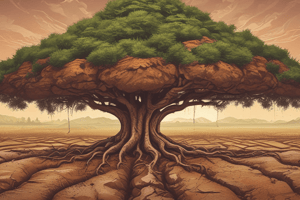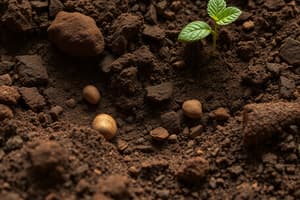Podcast
Questions and Answers
Which soil property is most directly indicated by the rate at which water flows through it?
Which soil property is most directly indicated by the rate at which water flows through it?
- Porosity
- Permeability (correct)
- Texture
- Structure
A soil sample is predominantly gritty. Which soil component is most likely dominant?
A soil sample is predominantly gritty. Which soil component is most likely dominant?
- Sand
- Clay
- Humus (correct)
- Silt
Which soil textural class typically has the highest water-holding capacity?
Which soil textural class typically has the highest water-holding capacity?
- Sandy Loam
- Loamy Sand
- Silty Clay (correct)
- Loam
How does soil color primarily influence soil temperature?
How does soil color primarily influence soil temperature?
Which of the following describes the arrangement of soil particles into aggregates?
Which of the following describes the arrangement of soil particles into aggregates?
Which soil property is described by the mass of dry soil per unit volume?
Which soil property is described by the mass of dry soil per unit volume?
What is the primary effect of high bulk density on plant growth?
What is the primary effect of high bulk density on plant growth?
A soil has a pH of 5.0. What amendment would best help raise the pH to a more optimal level for most plants?
A soil has a pH of 5.0. What amendment would best help raise the pH to a more optimal level for most plants?
How does organic matter content primarily improve soil structure?
How does organic matter content primarily improve soil structure?
What does a high cation exchange capacity (CEC) indicate about a soil's fertility?
What does a high cation exchange capacity (CEC) indicate about a soil's fertility?
Flashcards
Soil Structure
Soil Structure
The arrangement of soil particles into aggregates.
Soil Texture
Soil Texture
The relative proportions of sand, silt, and clay in a soil.
Soil Permeability
Soil Permeability
The capacity of a soil to transmit water and air.
Soil Porosity
Soil Porosity
Signup and view all the flashcards
Soil Color
Soil Color
Signup and view all the flashcards
Soil Bulk Density
Soil Bulk Density
Signup and view all the flashcards
Soil Moisture Content
Soil Moisture Content
Signup and view all the flashcards
Soil Tilth
Soil Tilth
Signup and view all the flashcards
Soil Strength
Soil Strength
Signup and view all the flashcards
Soil Temperature
Soil Temperature
Signup and view all the flashcards
Study Notes
- Soil is composed of mineral particles, organic matter, water, and air
- Texture refers to the proportion of sand, silt, and clay in the soil
- Structure describes the arrangement of soil particles into aggregates
- Color can indicate mineral composition and organic content
- Density affects porosity, water infiltration, and root penetration
- Porosity determines water-holding capacity and aeration
- Water content influences plant growth and soil strength
- Temperature affects biological activity and seed germination
- Soil strength is the ability of soil to resist deformation
- Electrical conductivity indicates the amount of salts in the soil
Soil Texture
- Sand particles are the largest, ranging from 0.05 to 2.0 mm
- Silt particles are medium-sized, ranging from 0.002 to 0.05 mm
- Clay particles are the smallest, less than 0.002 mm
- Loam is a balanced mixture of sand, silt, and clay
- Textural triangle is used to classify soil types based on the percentage of sand, silt, and clay
Soil Structure
- Granular structure consists of small, rounded aggregates
- Blocky structure consists of irregular, cube-like aggregates
- Prismatic structure consists of tall, pillar-like aggregates
- Platy structure consists of thin, horizontal plates
- Single-grained structure consists of individual particles with no aggregation
- Structure affects aeration, water infiltration, and root penetration
Soil Color
- Munsell color chart is used to describe soil color
- Hue indicates the dominant spectral color (e.g., red, yellow)
- Value indicates the lightness or darkness of the color
- Chroma indicates the intensity or purity of the color
- Dark colors often indicate high organic matter content
- Red colors often indicate the presence of iron oxides
- Gray or bluish colors often indicate poor drainage
Soil Density
- Bulk density is the mass of dry soil per unit volume
- Particle density is the mass of solid particles per unit volume
- Porosity is the percentage of soil volume occupied by pores
- High bulk density indicates low porosity
- Compaction increases bulk density and reduces porosity
- Density affects water infiltration, aeration, and root penetration
Soil Water
- Saturation is the state when all soil pores are filled with water
- Field capacity is the amount of water held in the soil after excess water has drained away
- Wilting point is the soil moisture content at which plants can no longer extract water
- Available water is the difference between field capacity and wilting point
- Infiltration is the process by which water enters the soil
- Percolation is the movement of water through the soil
Soil Temperature
- Soil temperature affects seed germination, root growth, and microbial activity
- Mulch can insulate the soil and moderate temperature fluctuations
- Dark-colored soils warm up faster than light-colored soils
- Soil moisture content affects soil temperature
- High soil temperatures can damage plant roots
- Freezing and thawing can affect soil structure
Soil Strength
- Cohesion is the attraction between soil particles
- Adhesion is the attraction between soil and other surfaces
- Soil strength affects root penetration and erosion resistance
- Compaction increases soil strength
- Moisture content affects soil strength
- Dry soils are generally stronger than wet soils
Soil Electrical Conductivity
- Electrical conductivity (EC) measures the amount of salts in the soil
- High EC indicates high salinity
- Salinity can inhibit plant growth
- EC is measured in deciSiemens per meter (dS/m)
- Leaching can reduce soil salinity
- Soil amendments can help to reduce salinity
Studying That Suits You
Use AI to generate personalized quizzes and flashcards to suit your learning preferences.
Description
Explore the components of soil: mineral particles, organic matter, water, and air. Understand soil texture by examining sand, silt, and clay proportions. Learn how to classify soil types using the textural triangle.




